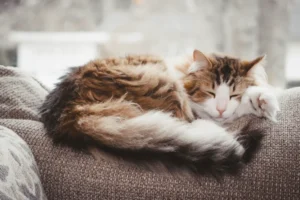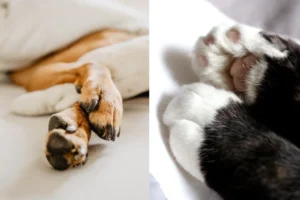Cats are known for their incredible hunting abilities, often leaving their owners in awe of their skills. But why are cats such good hunters? Let’s delve into the reasons behind their impressive hunting prowess.
Cats have natural instincts and physical attributes that make them exceptional hunters. From keen senses to unique hunting techniques, their skills are unmatched in the animal kingdom. So, why are cats such good hunters? Let’s explore the fascinating reasons behind their hunting prowess.
Keen Senses
Cats possess sharp senses of sight, smell, and hearing that make them exceptional hunters. Their keen eyesight allows them to detect even the slightest movements of their prey, helping them track and pounce with precision. Their acute sense of smell helps cats locate prey, even if it is hidden or out of sight. Additionally, cats have excellent hearing, which enables them to detect the faintest sounds of potential prey rustling in the underbrush. These heightened senses give cats a significant advantage when hunting, allowing them to efficiently locate and capture their next meal.
Stealth and Agility
Cats are not only equipped with keen senses but also possess remarkable stealth and agility that aid them in their hunting endeavors. Their ability to move silently and with grace allows them to sneak up on prey without being detected, giving them the element of surprise. Cats’ flexible bodies and powerful muscles enable them to pounce and chase with incredible speed and precision, making it difficult for their prey to escape. Their agile movements and nimble reflexes make them formidable predators in the wild, showcasing their prowess as skilled hunters.
- Crouching Tiger, Hidden Hunter: Cats use a hunting technique called the “stalk-and-pounce” method, where they crouch low to the ground, slowly approaching their prey before swiftly pouncing to capture it. This stealthy approach coupled with their lightning-fast reflexes makes them efficient hunters.
- Silent Stalkers: Cats have specialized paw pads that dampen the sound of their footsteps, allowing them to move quietly and undetected while on the prowl. This silent approach gives them the advantage of surprising their prey before it has a chance to flee.
Hunting Techniques
Cats are stealthy and agile predators, employing various hunting techniques to catch their prey. Their primary strategy involves stalking, where they move quietly and slowly towards their target, minimizing noise and maximizing surprise. Once in striking distance, cats use their powerful hind legs to pounce on their prey with lightning speed, ensuring a quick and effective kill. Additionally, cats often practice their hunting skills through play, engaging in activities that simulate stalking, pouncing, and capturing movements, honing their abilities even when not hunting.
Natural Instincts
Cats possess innate hunting instincts that drive them to hunt, even when they are well-fed domesticated pets. These instincts are deeply rooted in their DNA, dating back to their wild ancestors. Cats have a strong prey drive, fueled by their natural instinct to exhibit hunting behavior, such as chasing, stalking, and capturing. This drive is not solely motivated by hunger but also by the thrill of the hunt and the satisfaction of catching prey. Therefore, even when provided with ample food, cats will engage in hunting behavior as a way to satisfy their primal instincts and exercise their natural skills.
Additional Unique Insight:
- Hunting Efficiency: Cats have exceptional night vision, heightened senses of smell and hearing, and retractable claws, all of which contribute to their effectiveness as hunters. Their superior sensory abilities allow them to detect even the slightest movements or sounds, giving them a significant advantage when stalking prey. Furthermore, retractable claws enable cats to maintain sharpness and precision in their attacks, ensuring a swift and accurate capture. These evolutionary adaptations enhance their hunting efficiency and make them formidable predators in their environment.
Adaptability
Cats are exceptional hunters due to their incredible adaptability. They can adjust their hunting techniques based on the environment and the type of prey they are targeting. Whether it’s stalking silently through tall grass to catch a bird or utilizing their lightning-fast reflexes to pounce on a mouse indoors, cats showcase remarkable versatility in their hunting skills. This adaptability makes them effective hunters in a wide range of settings, from the great outdoors to urban landscapes. Their ability to quickly switch tactics depending on the circumstances sets them apart as highly skilled and successful predators.
Great Hunters Throughout History
Throughout history, cats have played a vital role as hunters, helping control pest populations and maintain ecological balance. Since ancient times, humans have recognized and valued cats for their hunting abilities. In ancient Egypt, cats were revered for their skill in keeping grain storehouses free of rodents. Sailors on ships would bring cats along to catch vermin that could spoil food supplies. Even today, cats continue to be excellent hunters, both as beloved pets and as independent felines in various environments. Their innate hunting instincts and efficiency in controlling pest populations have cemented their place as valuable contributors to ecosystems worldwide.
Additional Insight:
– Cats have specialized eyesight and hearing that aid them in detecting even the slightest movements or sounds, making them even more effective hunters in various conditions.
Interesting Facts about Cat Hunting
Cats have a specialized eye structure that allows them to see in low light conditions, making them excellent nocturnal hunters. Their eyes have a higher concentration of rod cells, which are sensitive to light, giving them the advantage in the dark.
A cat’s whiskers are more than just cute accessories
– they help cats navigate and hunt effectively. Whiskers are sensitive tactile hairs that help cats detect changes in their environment, aiding them in stalking prey and moving through tight spaces.
Cats have a unique hunting style called “stalking,” where they silently observe their prey and carefully plan their attack. With their flexible bodies and sharp claws, cats can swiftly pounce on their target with precision.
Domestic cats still retain their wild instincts , which contributes to their hunting prowess. Even well-fed house cats may exhibit hunting behaviors, as it is an innate skill deeply rooted in their DNA.
Cats are efficient hunters due to their incredible agility and speed. They can silently sneak up on their prey and deliver a swift and fatal blow, showcasing their natural hunting abilities.
The Role of Play in Hunting Skills
Engaging in play as kittens is not just about having fun – it also plays a crucial role in developing their hunting skills. As young cats play with toys or each other, they mimic hunting behaviors such as stalking, pouncing, and chasing. This playful behavior helps them refine their coordination, balance, and agility, laying the foundation for successful hunting in adulthood.
Encouraging playtime for kittens is essential for honing their hunting instincts. Providing interactive toys, such as wand toys or laser pointers, can stimulate their natural predatory instincts and improve their hunting skills over time.
Kittens learn important hunting techniques through play, such as how to sneak up on prey, anticipate movement, and strike with precision. These skills acquired during playtime translate into effective hunting strategies as adult cats.
Play is not just a pastime for cats; it is a fundamental part of their development. Through play, cats learn valuable lessons that prepare them for real-life hunting scenarios, sharpening their instincts and increasing their chances of success in the wild.
Observing playful behaviors in kittens can provide insights into their future hunting abilities. Cats that show enthusiasm and skill during playtime are likely to become proficient hunters as they mature.
Tip: Providing puzzle feeders or treat-dispensing toys can also simulate the hunting experience for adult cats, keeping them mentally stimulated and physically active.
Relationship Between Domestic Cats and Hunting
Domestic cats’ hunting instincts stem from their wild ancestors’ need to hunt for survival. These instincts are ingrained in their DNA, making them natural hunters even in a household setting. Despite being pampered pets, cats retain their predatory skills, which can be both a blessing and a challenge for owners. Engaging in hunting behavior provides mental and physical stimulation for cats, keeping them active and agile. It also allows them to exhibit their natural behaviors, fulfilling a primal need.
While some may view hunting as a nuisance, it’s essential to understand that it’s a part of who cats are. As responsible pet owners, providing alternative outlets for hunting instincts, such as interactive toys and puzzle feeders, can help satisfy their natural drive without posing a threat to wildlife. Building a conducive environment that simulates a hunting experience can prevent cats from seeking out prey outside the home. By striking a balance between accepting their hunting nature and redirecting it appropriately, we can create a harmonious relationship with our feline companions.
Conservation Efforts and Cat Hunting
Cat hunting, especially by outdoor and feral cats, poses a significant threat to wildlife populations. Studies show that these hunting activities have led to the decline of many bird species and small mammals. As caring pet owners, it’s crucial to take steps to minimize the impact of our cats on local ecosystems. Keeping cats indoors or providing supervised outdoor time can help reduce their hunting opportunities and protect vulnerable wildlife.
To further support conservation efforts, consider implementing measures like bell collars or brightly colored collars, which can alert potential prey of a cat’s presence. Additionally, participating in Trap-Neuter-Return (TNR) programs for feral cats can help control their population and limit their impact on local wildlife. By actively addressing the issue of cat hunting and working towards solutions, we can contribute to preserving biodiversity and maintaining a balanced ecosystem.
Tips to Help Mitigate Cat Hunting:
- Provide Enrichment: Engage your cat with interactive toys and activities to satisfy their hunting instincts.
- Establish a Catio: Create a safe outdoor space for your cat to enjoy the sights and sounds of nature without posing a threat to wildlife.
- Consult with a Veterinarian: Discuss options such as indoor-only living or the use of deterrents to prevent hunting behavior.
- Support TNR Programs: Contribute to efforts that focus on managing feral cat populations in a humane and effective manner.
- Educate Others: Raise awareness about the impact of cat hunting on wildlife and encourage responsible pet ownership within your community.
Alex, a passionate animal lover, has experience in training and understanding animal behavior. As a proud pet parent to two dogs and three cats, he founded AnimalReport.net to share insights from animal experts and expand his knowledge of the animal kingdom.









